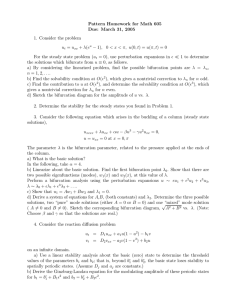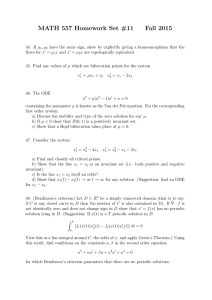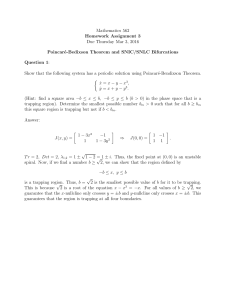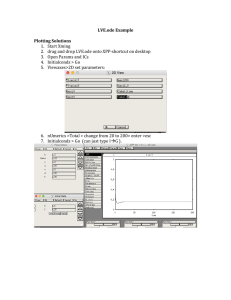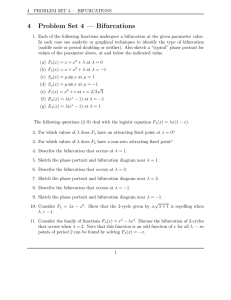Math 5470 § 1. Second Midterm Exam Name: Solutions
advertisement
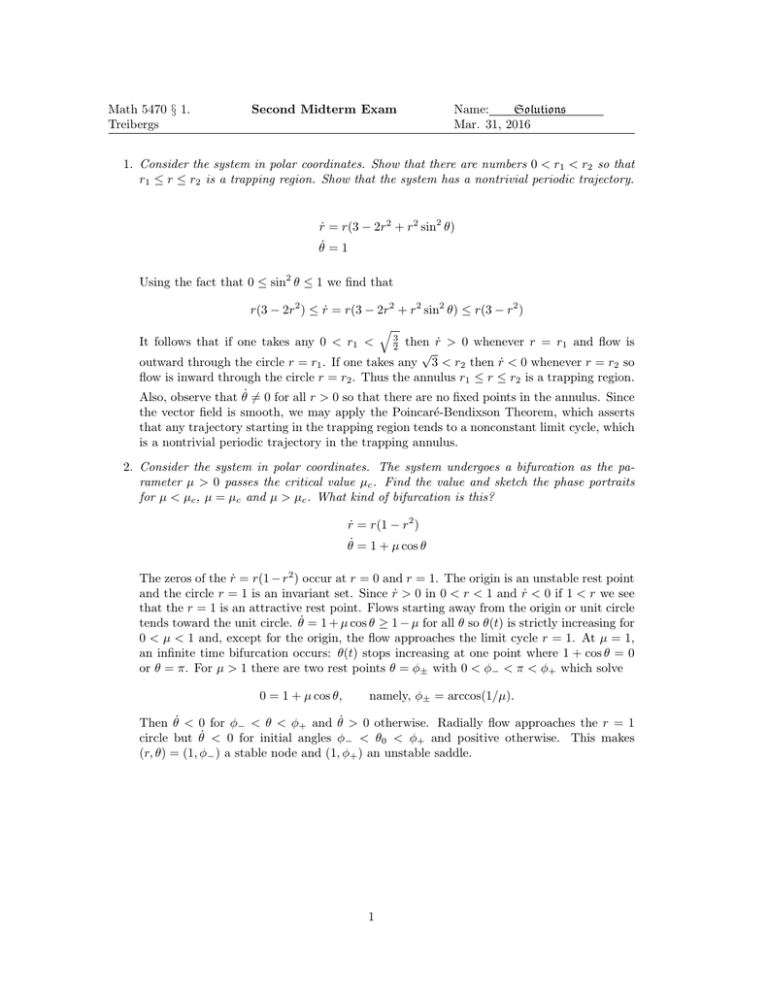
Math 5470 § 1. Treibergs Second Midterm Exam Name: Solutions Mar. 31, 2016 1. Consider the system in polar coordinates. Show that there are numbers 0 < r1 < r2 so that r1 ≤ r ≤ r2 is a trapping region. Show that the system has a nontrivial periodic trajectory. ṙ = r(3 − 2r2 + r2 sin2 θ) θ̇ = 1 Using the fact that 0 ≤ sin2 θ ≤ 1 we find that r(3 − 2r2 ) ≤ ṙ = r(3 − 2r2 + r2 sin2 θ) ≤ r(3 − r2 ) q 3 It follows that if one takes any 0 < r1 < 2 then ṙ > 0 whenever r = r1 and flow is √ outward through the circle r = r1 . If one takes any 3 < r2 then ṙ < 0 whenever r = r2 so flow is inward through the circle r = r2 . Thus the annulus r1 ≤ r ≤ r2 is a trapping region. Also, observe that θ̇ 6= 0 for all r > 0 so that there are no fixed points in the annulus. Since the vector field is smooth, we may apply the Poincaré-Bendixson Theorem, which asserts that any trajectory starting in the trapping region tends to a nonconstant limit cycle, which is a nontrivial periodic trajectory in the trapping annulus. 2. Consider the system in polar coordinates. The system undergoes a bifurcation as the parameter µ > 0 passes the critical value µc . Find the value and sketch the phase portraits for µ < µc , µ = µc and µ > µc . What kind of bifurcation is this? ṙ = r(1 − r2 ) θ̇ = 1 + µ cos θ The zeros of the ṙ = r(1 − r2 ) occur at r = 0 and r = 1. The origin is an unstable rest point and the circle r = 1 is an invariant set. Since ṙ > 0 in 0 < r < 1 and ṙ < 0 if 1 < r we see that the r = 1 is an attractive rest point. Flows starting away from the origin or unit circle tends toward the unit circle. θ̇ = 1 + µ cos θ ≥ 1 − µ for all θ so θ(t) is strictly increasing for 0 < µ < 1 and, except for the origin, the flow approaches the limit cycle r = 1. At µ = 1, an infinite time bifurcation occurs: θ(t) stops increasing at one point where 1 + cos θ = 0 or θ = π. For µ > 1 there are two rest points θ = φ± with 0 < φ− < π < φ+ which solve 0 = 1 + µ cos θ, namely, φ± = arccos(1/µ). Then θ̇ < 0 for φ− < θ < φ+ and θ̇ > 0 otherwise. Radially flow approaches the r = 1 circle but θ̇ < 0 for initial angles φ− < θ0 < φ+ and positive otherwise. This makes (r, θ) = (1, φ− ) a stable node and (1, φ+ ) an unstable saddle. 1 c Figure 1: Plots with µ = .5, 1, 1.3 using 3D-XPlorMath 2 3. Answer the following questions about periodic trajectories. (a) Show that this equation has no nontrivial periodic solutions. ẍ + x2 ẋ + x = 0. Viewing this as a spring equation with nonnegative drag depending on velocity, one expects that energy decay under the flow. Written as a system ẋ = y ẏ = −x − xy 2 Computing d x2 + y 2 d E= = x ẋ + y ẏ = xy + y(−x − xy 2 ) = −x2 y 2 ≤ 0. dt dt 2 If (x, y) 6= (0, 0), the flow does not stop at x = 0 because ẋ = y 6= 0 nor at y = 0 because then ẏ = −x 6= 0. Otherwise Ė < 0 so the energy is strictly decreasing function of time. It follows that there cannot be nontrivial periodic trajectories because the energy cannot be periodic. (b) Show that this equation has a nontrivial periodic solution. ẍ + x (ẋ)2 + x = 0. Written as a system ẋ = y = f (x, y) 2 ẏ = −x − x y = g(x, y) This system is reversible because f (x, −y) = −f (x, y) is odd in y and g(x, −y) = g(x, y) is even in y. Its only zero is when 0 = f (x, y) = y hence y = 0 and when 0 = g(x, 0) = −x so x = 0 as well. Linearizing at zero we find 0 1 0 1 J(0, 0) = = 2 −1 − 2xy −x −1 0 (x,y)=(0,0) which is a matrix whose eigenvalues are ±i. The origin is a center for the linearized equation. By the theorem about centers for reversible systems, because the vector field is smooth and because the reversible system has centers for the linearization at a rest point, then the nonlinear system, too, has centers at the rest point. In particular, the origin in this problem is surrounded by closed nontrivial trajectories. 3 4. The system undergoes a bifurcation as the parameter µ passes the critical value µc . Find the value. Find the critical points and determine their stability. Sketch the phase portraits for µ < µc , µ = µc and µ > µc . What kind of bifurcation is this? ẋ = −x + y + y(µ − y) = f (x, y) ẏ = y(µ − y) = g(x, y) The rest points are at solutions of 0 = g(x, y) = y(µ − y) which is at y = 0 or y = µ. If y = 0 then 0 = f (x, 0) = −x so x = 0. If y = µ then 0 = f (x, µ) = −x + µ so x = µ. Computing the Jacobian we find −1 J(x, y) = 0 1 + µ − 2y −1 ; J(0, 0) = 0 µ − 2y 1 + µ −1 ; J(µ, µ) = 0 µ 1 − µ −µ At (0, 0), the eigenvalues are −1 and µ with corresponding eigenvectors 10 and 11 . At (µ, µ), the eigenvalues are −1 and −µ with corresponding eigenvectors 10 and 11 . Thus for µ > 0, the rest point (0, 0) is a saddle and the rest point (µ, µ) is a stable node. The points swap roles if µ < 0 when the rest point (0, 0) is a stable node and the rest point (µ, µ) is a saddle. Thus a transcritical bifurcation occurs at (0, 0) when µ = µc = 0. c Figure 2: Plots with µ = .5, 0, −.5 using 3D-XPlorMath 4 5. Consider the system ẋ = µx − y + (µ + 1)x2 − xy ẏ = x + x = f (x, y) 2 = g(x, y) (a) The system undergoes a Hopf Bifurcation when the parameter µ passes a critical value µc . What is this critical value? What are the rest points? Can you tell if the bifurcation is subcritical or supercritical? The rest points satisfy 0 = g(x, y) = x(1 + x) so x = 0 or x = −1. If x = 0 then 0 = f (0, y) = −y implies y = 0. If x = −1 at a rest point then 0 = f (−1, y) = −µ − y + (µ + 1) + y = 1 has no solution. Thus (0, 0) is the only rest point for all µ. Computing the Jacobian we find µ + 2(1 + µ)x − y J(x, y) = 1 + 2x −1 − x ; 0 µ −1 J(0, 0) = 1 0 Its characteristic equation is (µ − λ)(−λ) + 1 = λ2 − µλ + 1 = 0 whose solutions are p µ2 − 4 2 For |µ| < 2, as µ crosses µc = 0, the eigenvalues are complex with real part µ/2. Thus the Hopf bifurcation occurs at µc = 0 when the conjugate eigenvalues cross the imaginary axis. If −2 < µ < 0, the origin is a stable spiral if and if 0 < µ < 2, an unstable spiral. For µ < −2, the origin is a stable node (both eigenvalues are negative) and if µ > 2 and an unstable node (both eigenvalues are positive). Consider the energy. For trajectories λ= µ± d E = xẋ + y ẏ = x(µx − y + (µ + 1)x2 − xy) + y(x + x2 ) = µx2 + (1 + µ)x3 dt so at least if µ = −1 the energy is strictly decreasing (the flow doesn’t stop when x = 0 because then ẋ = −y) hence no periodic solutions. This suggests that periodic solutions occur when µ > 0 when the origin is unstable. Thus the bifurcation is supercritical. (b) What is the index at the origin of the vector field in part (a)? Does it depend on µ? Why? [Hint: Does it help you to know that a Hopf Bifurcation occurs?] We know that a Hopf Bifurcation occurs, so that for some µ > 0 there is a periodic solution C that surrounds the origin. Since there are no rest points other than the origin, the index of C gives the index at the origin. Because the vector field is tangent to C, IC = 1, which is the index at the origin for such µ. The index is the same for every µ. We know that the origin is the only rest point for any µ so the vector field never vanishes away form the origin, and we know that the vector field varies continuously as µ is varied. Hence the total angle change of the vector field on a fixed loop C around the origin varies continuously. But as the angle change is an integer multiple of 2π, it has to be constant. The index is confirmed for any µ such that |µ| > 2 since the origin is a node or for any 0 < |µ| < 2 when the origin is a spiral, both of whose index is one. 5

